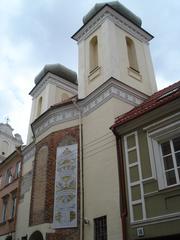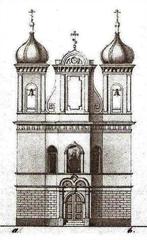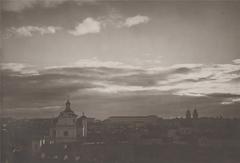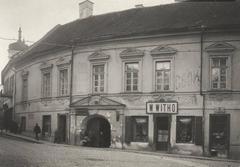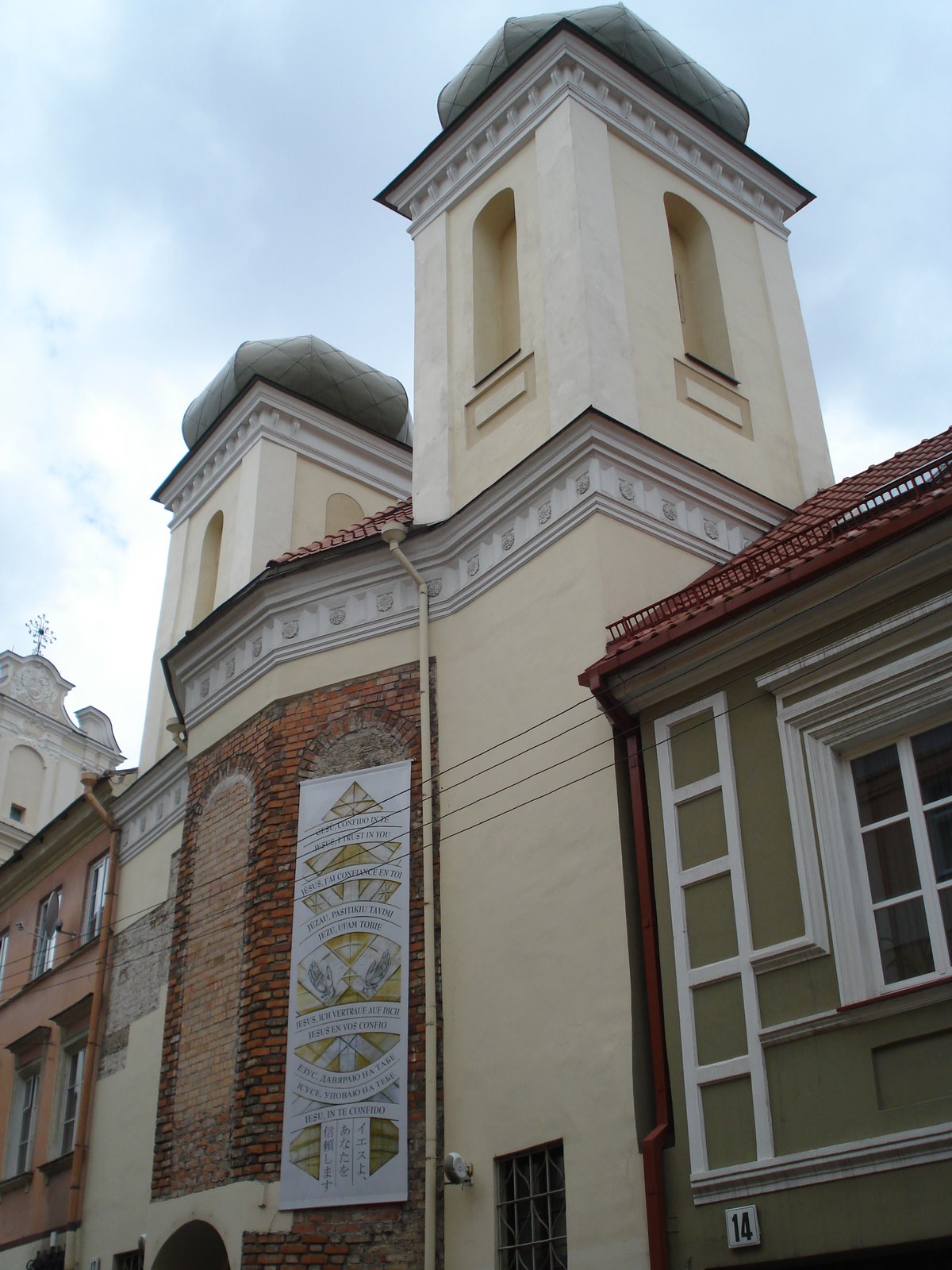
Divine Mercy Sanctuary Vilnius: Visiting Hours, Tickets & Comprehensive Pilgrimage Guide
Date: 15/06/2025
Introduction
Nestled in Vilnius’ UNESCO-listed Old Town, the Divine Mercy Sanctuary stands as a beacon of faith, history, and culture. Home to the original Divine Mercy image painted under St. Faustina Kowalska’s direction, this sanctuary draws pilgrims and visitors from around the world. Here, you’ll find everything you need to plan your visit—from historical context and theological significance to practical details on visiting hours, tickets, etiquette, and nearby attractions.
Historical Background and Significance
Roots of Devotion in Vilnius
Vilnius’ religious heritage stretches back centuries, most notably with the veneration of Our Lady of the Gate of Dawn since the 1600s. The city became a spiritual center, with the Gate of Dawn’s miraculous icon canonically crowned as the Mother of Mercy by Pope Pius XI in 1927 (Catholic Online). This legacy set the stage for the emergence of the Divine Mercy devotion, which would transform Vilnius into a focal point for global pilgrimage.
St. Faustina Kowalska and the Divine Mercy Image
Between 1933 and 1936, St. Faustina Kowalska lived in Vilnius, guided by Blessed Michael Sopocko. During this time, she received visions of Jesus and was instructed to commission an image embodying Divine Mercy. The artist Eugeniusz Kazimirowski painted the now-famous image in 1934, following Faustina’s detailed direction. The painting, depicting Christ with rays of red and pale light emanating from His heart and bearing the inscription “Jesus, I trust in You,” became the cornerstone of the devotion (catholicshrinebasilica.com).
The image was first publicly displayed at the Chapel of the Gate of Dawn in April 1935, marking a seminal moment for the devotion. Vilnius’ turbulent political history meant the image endured years of upheaval—hidden, moved, and eventually restored after Lithuanian independence (Irish Rover).
Establishment of the Sanctuary
In 2005, the restored image found a permanent home in the former Church of the Holy Trinity, now the Divine Mercy Sanctuary, in Vilnius Old Town. This modest yet spiritually resonant church houses the only Divine Mercy image seen by St. Faustina herself (gailestingumas.lt).
Theological and Spiritual Significance
Central to the Divine Mercy devotion is the message of God’s limitless mercy, trust in Jesus, and the practice of acts of mercy. The image’s rays symbolize Christ’s blood (red) and the water of baptism and the Holy Spirit (pale). The inscription “Jesus, I trust in You” encapsulates the entire devotion’s core. St. Faustina’s diary, “Divine Mercy in My Soul,” documents these revelations and continues to inspire millions (catholicshrinebasilica.com).
Pilgrimage Traditions and Cultural Impact
Vilnius is alive with pilgrimage traditions:
- Divine Mercy Sunday: Celebrated on the first Sunday after Easter, this is the sanctuary’s principal feast, drawing thousands for Masses, processions, and the Chaplet at 3:00 p.m.
- Way of Light Procession: Held on the eve of Divine Mercy Sunday, this event links the Gate of Dawn with the sanctuary.
- Feast of Our Lady Mother of Mercy (November 16): An eight-day celebration with special Masses, novenas, and veneration opportunities (catholicshrinebasilica.com).
These events, along with ongoing daily devotions, reinforce Vilnius as a major spiritual destination.
Visiting Hours and Ticket Information
- Opening Hours: The sanctuary is open 24/7, one of the few religious sites in Vilnius with perpetual access (pilgrim-info.com).
- Admission: Entry is free; no tickets are required. Donations are appreciated.
- Peak Times: Divine Mercy Week (Easter Monday to Divine Mercy Sunday) is the busiest period. For quieter visits, come on weekdays or early mornings.
Sanctuary Layout and Atmosphere
Situated at Dominikonų Street 12, Vilnius, the sanctuary occupies the former Holy Trinity Church. The interior is simple and contemplative, focusing attention on the main altar and the original Divine Mercy image (govilnius.lt). Notable features include:
- Graffitos by Nijolė Vilutytė: Depicting the Holy Mother of Mercy and the prayer “Jesus, I trust in you” in eleven languages.
- Original Divine Mercy Image: Painted under St. Faustina’s guidance, it is the centerpiece for prayer and veneration (gailestingumas.lt).
Liturgical Schedule and Devotions
- Daily Masses: Celebrated in Lithuanian and Polish; check the official schedule for updates.
- Perpetual Adoration: The Blessed Sacrament is exposed for 24-hour adoration (pilgrim-info.com).
- Chaplet of Divine Mercy: Prayed daily at 3:00 p.m.
- Confession: Available daily in multiple languages.
- Feast Days: Major celebrations on Divine Mercy Sunday and September 13–14.
Pilgrimage Etiquette and Practical Tips
- Silence and Reverence: Speak softly or remain silent, especially during services or adoration.
- Modest Dress: Shoulders and knees covered; hats removed upon entry.
- Photography: Permitted in non-liturgical times; avoid flash and always respect posted signs.
- Participation: All are welcome to attend Mass; non-Catholics should refrain from receiving Communion but may join in prayer.
Accessibility and Facilities
- Wheelchair Access: The sanctuary is accessible, but the Old Town’s cobblestone streets may pose challenges.
- Facilities: Restrooms are located nearby; cafés and hotels are within walking distance (thecatholictravelguide.com).
- Guided Tours: Available in several languages and can be arranged via the sanctuary’s website or local tourism offices.
- Multilingual Services: Masses and confessions primarily in Lithuanian and Polish, with occasional English or Russian. Printed materials are offered in multiple languages.
How to Get There
- Address: Dominikonų g. 12, Vilnius 01131, Lithuania (gailestingumas.lt)
- Public Transport: Multiple bus and trolleybus routes serve the Old Town; the sanctuary is a short walk from main stops.
- Parking: Limited in the area; public parking lots are available nearby.
Nearby Attractions and Pilgrimage Routes
- Gate of Dawn: Marian chapel and major pilgrimage site.
- House of Saint Faustina: Museum and pilgrimage site at Grybo 29a.
- Church of the Holy Spirit: Historic Gothic church close by.
- Church of St. Michael: Connected to the Divine Mercy image’s history.
- Way of Divine Mercy: Pilgrimage route linking these spiritual landmarks (pilgrim-info.com).
Virtual Tours and Media
- Live Webcam: Participate in Mass and adoration remotely (gailestingumas.lt).
- Virtual Tours: In development; video documentaries available online (thecatholictravelguide.com).
- Images: See original Divine Mercy image and sanctuary views with descriptive alt text for accessibility.
Frequently Asked Questions (FAQ)
Q: Is there an entrance fee?
A: No, admission is free. Donations are welcome.
Q: What are the sanctuary’s hours?
A: Open 24 hours a day, seven days a week.
Q: Are guided tours available?
A: Yes, arrange through the sanctuary or local tourism offices.
Q: Is the sanctuary wheelchair accessible?
A: Yes, though some Old Town streets can be challenging.
Q: Can I take photos inside?
A: Permitted outside services; always check signs or ask staff.
Visuals and Interactive Resources
Alt text: Divine Mercy Sanctuary in Vilnius exterior view showing historic building.
Alt text: The original Divine Mercy image displayed inside the sanctuary.
Alt text: Map of Divine Mercy Sanctuary and nearby Vilnius historical sites.
Recommendations for a Meaningful Visit
- Participate in the Chaplet at 3:00 p.m.
- Spend time in adoration.
- Attend a Mass, regardless of language.
- Reflect before the original Divine Mercy image.
- Explore related sites like the House of Saint Faustina and the Gate of Dawn.
- Engage with local parishioners and fellow pilgrims.
Safety and Security
Vilnius is safe for visitors. Remain respectful and quiet in the sanctuary. Keep personal belongings secure, especially during crowded feast days. Sanctuary staff are available for assistance.
Call to Action
Plan your visit to the Divine Mercy Sanctuary in Vilnius today. For the latest visiting hours, schedules, and virtual participation, visit the official sanctuary website. Download the Audiala app for guided tours and real-time updates, and follow us on social media for live stories, event announcements, and spiritual inspiration.
Summary
The Divine Mercy Sanctuary is not only a place of profound spiritual encounter but also a testament to Vilnius’ rich religious and cultural tapestry. Housing the original Divine Mercy image, it invites all—pilgrims and tourists alike—to experience the living heritage of Divine Mercy. Whether you seek prayer, historical insight, or cultural enrichment, the sanctuary’s 24/7 open doors and welcoming atmosphere ensure a memorable and meaningful journey.
For more details, consult the official sanctuary site and related tourism resources. Embrace the opportunity to explore, reflect, and connect with the Divine Mercy community in the heart of Lithuania.
Official Sources and Further Reading
- Catholic Online
- Catholic Shrine Basilica
- Pilgrim Info
- Govilnius
- The Catholic Travel Guide
- Irish Rover
